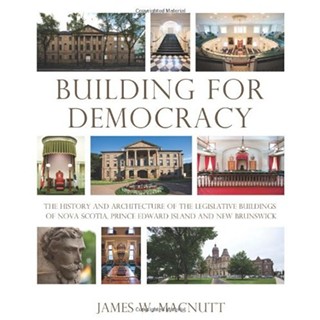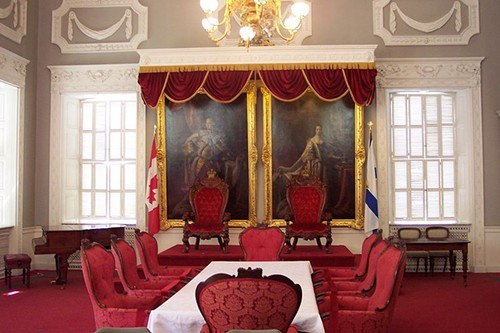
We shape our buildings, and afterwards our buildings shape us — Winston Churchill.
Nova Scotia’s legislative building is an architectural gem that should be designated a world heritage site according to James Macnutt, author of Building for Democracy, a new book released today in the historic Red Room at Province House.
“This building is truly spectacular and international in its significance,” Macnutt told about 50 people who had gathered for the launch of his book which also celebrates the history and beauty of the legislative buildings in New Brunswick and Prince Edward Island.
“One of the surprising things in Canada is that we fail to recognize that we have extraordinary architectural treasures,” he added, “important sites that other countries would celebrate.”
Macnutt says he’s hoping the three Maritime legislatures will pass resolutions calling for their buildings to be added to the 15 heritage sites in Canada that have already been designated by UNESCO, the United Nations Educational, Scientific and Cultural Organization. So far, only two sites have won UNESCO recognition in the Maritimes — the old town of Lunenburg and the Joggins fossil cliffs, both in Nova Scotia.
“The [UNESCO] designation is extraordinarily important because it gives international recognition and stature,” Macnutt says. “Also, there are people, tourists who literally travel the world to visit UNESCO sites.”
Macnutt points out that Nova Scotia’s legislature is one of the oldest British parliaments in the world. It is also among the most elegant of public buildings and was inspired by principles developed by Robert Adam, a renowned 18th century Scottish architect who was influenced by ancient Greek and Roman architecture.
"When this building was being designed and constructed between 1811 and 1819, the builders of this particular place had it as their intention to create the single most important secular building in this province," he says. "It is an assertion of the self-confidence of the people of this province in their own ability to govern themselves."
Macnutt’s book takes readers on a pictorial tour of the Maritime legislatures featuring the work of Michael Needham who took about 9,000 photos of the three buildings. The tour of Nova Scotia’s Province House shows the sweep of the grand, imperial staircase that conducts visitors to the second floor which once housed Nova Scotia’s Upper Chamber or Senate (now the Red Room), the Supreme Court (now the legislative library) and the House of Assembly where MLAs have debated provincial legislation for nearly 200 years.
Significantly, those who climb the staircase find the Red Room (red, the imperial colour of British nobility) to their right and the House of Assembly to their left reflecting the British preference for right over left. Macnutt noted that in the House of Assembly, government politicians traditionally sit to the speaker’s right.
House speaker, Charlie Parker says he hopes the new book will entice more Nova Scotians to visit Province House to see its beauty and elegance for themselves. Parker, along with the speakers in New Brunswick and PEI, cooperated with Macnutt in producing the book which is published by James Lorimer's Formac Publishing Company based in Halifax.















